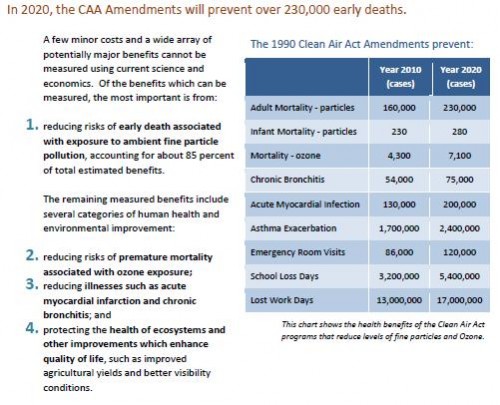The EPA report on the economic and health benefits of the Clean Air Act provisions that reduce levels of fine particles and ozone has been released and reaches four important conclusions:
- Economic benefits total more than $2 trillion dollars by 2020
- CAA benefits exceed costs by a factor of 30:1 [$2 trillion in benefits to $65 billion in costs]
- Cleaner air resulting from CAA programs improves the economy by reducing health costs and boosting productivity
- In 2020, the CAA will prevent more than 230,000 American early deaths, including 280 infants
Key Point: This (EPA) study finds that despite the claims of the big polluters and their army of corporate lobbyists to the contrary, taking sensible steps to update clean air and water standards through the Clean Air Act does indeed foster innovation, job creation and economic growth while protecting public health and reducing early deaths in American adults and infants. Opponents of letting the EPA update clean air safeguards for smog, soot, mercury and carbon pollution say American businesses are not capable of innovating and adapting new technologies and creating new jobs; yet this report makes clear that we can protect our health and grow our economy at the same time.
Economic Benefits of the CAA
- A 2011 EPA study determined that the economic benefits of the Clean Air Act updates made in 1990 will exceed $2 trillion in economic activity in the US economy by 2020. In contrast, implementation costs approximately $65 billion.
- The report finds that the 1990 Clean Air Act updates of soot and smog standards provided enormous air quality and health benefits today and will grow as the programs fulfill their potential impact.
- Economic data show that we can protect public health and grow our economy at the same time. Between 1970 and 2009 total emissions of the six principal air pollutants fell by 63 percent, and private sector jobs and GDP grew by 86 percent and 204 percent respectively
Clean Air: A strong return on investment
- With an investment of $65 billion and a return of over $2 trillion, the Clean Air Act provides a tremendous return of more than $30 in benefits for every $1 in investment. Its hard to find a better economic return than the Clean Air Act.
- By spending hundreds of millions on lobbyists to prevent EPA from updating clean air standards now, the big polluters are working to stifle innovation and economic growth and would diminish the return on investment that new updates would provide.
- The special interests want you to believe that cleaner air means fewer jobs. The facts do not support them. With $2 trillion in projected economic benefits, the CAA is an effective economic growth policy with the added benefits of improving public health and protecting our air and water.
- As past performance indicates, there is no sound economic argument for blocking new updates to the Clean Air Act.
Clean Air: Reducing health costs, boosting productivity
- According to the 2011 EPA study, the economy is stronger with the CAA. Cleaner air leads to better health and productivity for American workers and less money spent on health care to treat air pollution-related health problems.
- The EPA’s research shows that long-term economic growth is greater and American household economic welfare is improved through benefits such as fewer sick days and lower medical costs. These benefits more than offset the economy-wide cost of investing in air pollution controls to reduce levels of life- and health-threatening air pollution.
- By 2020, existing CAA programs will significantly reduce instances of asthma attacks, emergency room visits, sick days, and missed school days.
The EPA report shows that because of the 1990 CAA updates…
- In 2010 13,000,000 lost work days were prevented, and by 2020 it will grow to 17,000,000
- In 2010 3.2 million lost school days were prevented and by 2020 it will grow to 5.4 million
- In 2010 86,000 emergency room visits were avoided and by 2020 it will grow to 120,000
- In 2010 asthma exacerbation instances were reduced by 1.7 million, by 2020 it will be 2.4 million
Clean Air Saves Lives
- The EPA study demonstrates that stronger clean air standards save lives. New proposed updates to the CAA that would limit smog, soot, mercury and carbon dioxide pollution will only enhance the life saving impact of the CAA and reduce deaths in American adults and infants related to these toxics.
The EPA report shows that because of the1990 updates to the CAA…
- Adult deaths were reduced by 160,000 in 2010 and by 2020 will be reduced by 230,000
- Infant deaths reduced by 230 in 2010 and by 2020 will be reduced by 280
- Mortality rates due to ozone exposure were reduced by 4,300 in 2010 and will be reduced by 7,100 by 2020
- Instances of chronic bronchitis were reduced by 54,000 in 2010 and will be reduced by 75,000 by 2020
- Instances of Acute Myocardial Infection were reduced by 130,000 in 2010 and will be reduced by 200,000 by 2020
- In 2010 asthma exacerbation instances were reduced by 1.7 million, by 2020 it will be 2.4 million
more here (pdf)

